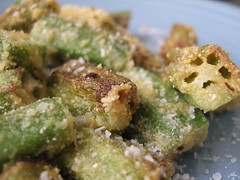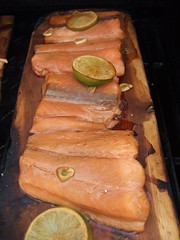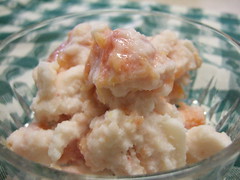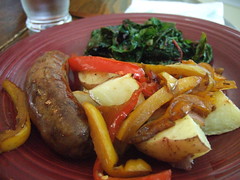Saturday, July 16, 2005
Heart Attack on a Plate
The okra came in just days before we left for Minnesota. I had to snag a small amount to snack on before leaving.
Wednesday, July 13, 2005
Salmon on a Plank
Marinated Teriyaki Salmon Cooked on a Cedar Plank
1 clove garlic, thinly sliced or 1 tablespoon jarred minced garlic
1 lime, sliced
10 oz teriyaki sauce
2 lbs salmon fillets
4 green onions, chopped
3 hours before: stir together garlic, teriyaki sauce and lime. Marinate salmon in sauce. Soak a cedar plank (14x7x1”) in water.
When you are ready to cook, heat the grill to medium-high. Remove the salmon from the marinade and discard the marinade. Remove cedar plank from water and coat the cooking side with oil.
Place the plank on the grill directly over the coals. Place the salmon on top of the plank (if your salmon has the skin still on, place it skin side up to prevent curling) and cover the grill. Cook until the salmon is almost done, when the all but the very center has turned opaque, approximately 10 minutes. Remove the salmon from the plank and place directly on top of the grill grates, turning after 2 minutes and finishing when the center just turns opaque.
Adapted from Aldi’s Fresh, Fun & Easy” cook booklet.
More about Plank Cooking
Using wood planks to cook food is a method that has been around for centuries. Early Native American cooks used wood planks over an open fire to naturally season fish and game. Today this method is employed by home cooks and gourmet chefs alike.
Planks for cooking can be made from cedar, alder, or even recycled oak wine barrels. They can be made at home by the household handyperson or purchased in gourmet cooking supply stores or on the internet. One can even use cedar shingles purchased at a building supply store!
Foods prepared on planks need not be limited to fish and the cooking appliance doesn’t necessarily have to be an outdoor grill. Indeed, plank cooking is an excellent way to experiment with various methods and foods.
To get you started, here are a few tips:
· Always soak your plank in water until fully saturated before using. Two to three hours is a good rule of thumb.
· A little coating of oil on the cooking surface will help prevent sticking, but don’t get oil on the underside, or you could have trouble with flare-ups.
· If you use a thin plank, such as a shingle, have a water bottle handy and don’t walk away. Even properly soaked, a plank will catch fire if the heat is too hot or the plank is too close to the flame. · If you decide to cook on a plank in the oven, stick with the thicker planks and keep the oven temperature to 350 degrees or less.
· After use, if your plank has not burned too much, clean it with hot water (no soap) and place back on a 350 degree grill or in the oven for 15 minutes.
Plank cooking is a great way to impart flavor to foods with minimal fuss. The dishwashers of the family will like them too, as clean-up is easy and the food can even be served right on the plank.
Surf the internet for recipes and methods and “play with your food!”
Information for this article was seasoned with information from http://greatlakesgrilling.com
Tuesday, July 12, 2005
Peach Ice Cream
I've decided I just don't like photographing peaches. The color just never seems to come out!
I've made this ice cream twice now. With my little Rival Electric Ice Cream Maker(1/5 qt capacity), making ice cream is an easy, last-minute dessert decision.
1 1/2 cup 1% milk
3/4 cup sugar
dash salt
1 cup 2% milk
1/2 cup half n half
1/2 tsp vanilla extract
3 or 4 peaches
Combine 1% milk, sugar and salt. Stir with a wire whisk until the sugar is dissolved. Stir in 2% milk, half n half and vanilla. Pour into freezer and begin freezing process.
Meanwhile, peel, pit and chop peaches. Mash them with a potato masher or, if you prefer no chunks in the ice cream, puree them in a food processor or blender.
When the ice cream is just about done, pour in the peaches. Continue freezing until the ice cream is the consistency recommended by the freezer manufacturer.
Pull out the freezer paddle, tamp down the ice cream with a spoon, loosely cover, and place the freezer into your refrigerator-freezer for 30 minutes or so.
Of course you can make a richer version of this ice cream subbing whole milk for the 2%, half n half for the 1% and whipping cream for the half n half. Because I could not find organic whipping cream up until 2 days ago, I started making this lower fat version. I'm not sure whether we'd even like the full fat version anymore.
Monday, July 11, 2005
Hot Sausage & 3 Peppers
So this meal was made with pork sausages.
3 pounds red potatoes, quartered
4 teaspoons olive oil, divided
3/4 teaspoons salt, divided
1/4 teaspoon freshly ground black pepper
6 hot italian turkey sausages (I had 5 in my package)
3 bell peppers, cut into strips (red, yellow, orange)
2 garlic cloves, minced
2 tablespoons balsamic vinegar
1 teaspoon dried rosemary
1/4 teaspoon crushed red pepper
Preheat oven to 375.
Arrange the potatoes in a single layer on a cookie sheet. Drizzle with 1 teaspoon oil, sprinkle with 1/2 teaspoon salt and black pepper. Toss to coat. Bake for 40 minutes or until tender, turning occasionally.
While the potatoes cook, heat 1 teaspoon oil in a large nonstick skillet over medium-high heat. Pierce the sausages several times and add to the pan. Cook 5 minutes or until lightly brown. Remove from pan.
Heat 2 teaspoons of oil in the pan. Add bell peppers; saute 5 minutes or until tender. Add garlic; saute 1 minute. Stir in 1/4 teaspoon salt, vinegar, rosemary and crushed red pepper. Return the sausages to the pan; cover and cook over medium-low heat until the sausages are done at 175 degrees, approximately 15 minutes.
From "Cooking Light" magazine, November, 2004. I served this with swiss chard sauteed in garlic-infused oil.



